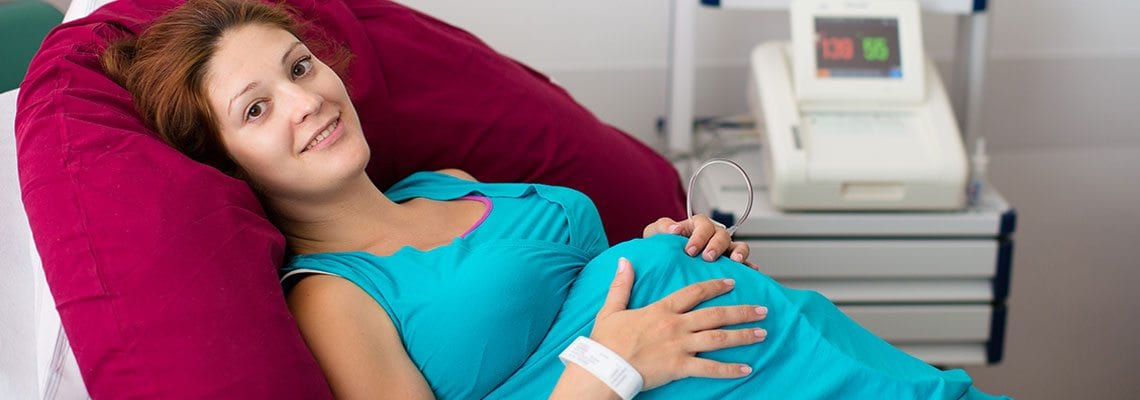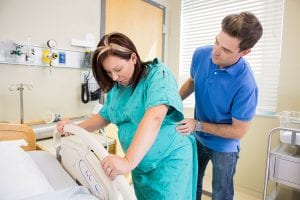
When it comes to labor and delivery planning one thing to consider it your positioning and movement. Repeated movement and physical activities such as walking or alternating positions can help influence the overall process and may even ease the pain women will likely experience during this joyful, yet painful rite of passage.
The Benefits of Movement During Labor
 While pain relief might be the most obvious benefit when it comes to movement during labor, physical exertion may prove beneficial in other ways as well. Many doctors, as well as women who have experienced childbirth, believe movement can also reduce the anxiety expectant mothers feel.
While pain relief might be the most obvious benefit when it comes to movement during labor, physical exertion may prove beneficial in other ways as well. Many doctors, as well as women who have experienced childbirth, believe movement can also reduce the anxiety expectant mothers feel.
Labor is a big deal, and for many women that major event can spark excessive worry, which can in turn lead to a build-up of anxiety that can manifest into actual medical issues during labor. These issues can include an increased heart rate and excessive elevated blood pressure. In certain instances, such problems could potentially harm both the mother and soon-to-be newborn baby. Exercise and physical movement can serve as a constructive way for a woman in labor to channel her nervousness and may also make expectant mothers less reliant on pain medications.
Under certain circumstances, labor pains can become so severe that a doctor might need to administer pain-alleviating drugs. However, the analgesic medications used for labor pain may precipitate side effects on the mother and baby. Using movement to cope with this pain eliminates such risks.
The Importance of Changing Positions
A number of different exercises/movements can be employed during labor. That being said, the circumstances surrounding each woman’s pregnancy will often dictate to what extent she will be able and/or permitted to move during labor. However, most medical professionals agree that an expectant mother should avoid lying flat on her back, as the supine position is believed to lengthen the duration of labor. During labor, remaining upright can also help reduce the risk of episiotomy, and thus reduce pain in recovery
There are many position options when it comes to labor but the benefits to changing positions throughout the process can arise from the positions themselves depending on the stage of labor and the baby’s position. For example, different poses or movements may aid in various aspects. During early labor, studies show that the uterus is more efficient when the mother is walking or moving and these movements and positions can encourage the baby to descend into the birth canal.
Moving throughout the labor process can also assist in aligning the mother’s, which can improve and increase the diameter of the pelvis, making each contraction more effective, so the pelvis and the cervix open more.
[wdca_ad id=”30576″ ]
Movements That Provide the Most Pain Relief
 Specific conditions might necessitate limited or no movement. These include cases where the unborn child is facing a form of distress, the woman is bleeding or if the baby is positioned in an awkward position. When the mother-to-be must remain in bed, keeping her head up as much as possible could lessen her discomfort level. When a woman’s pregnancy is progressing without complications, she may find relief from labor pain by practicing any one or combination of the following techniques:
Specific conditions might necessitate limited or no movement. These include cases where the unborn child is facing a form of distress, the woman is bleeding or if the baby is positioned in an awkward position. When the mother-to-be must remain in bed, keeping her head up as much as possible could lessen her discomfort level. When a woman’s pregnancy is progressing without complications, she may find relief from labor pain by practicing any one or combination of the following techniques:
Standing.
It is recommended that the expectant mother lean against an object large enough to support her frame.
Sitting Upright.
Such movement can be carried out in bed, in a seat, or atop a couch or sofa. The mother-to-be leans her back on a bed’s headboard, several propped pillows or against the backside of a chair or article of furniture.
Turning on One Side.
This practice is thought to reduce contractions and stabilize the expectant mother’s blood pressure.
Squatting.
A woman properly executes this technique by gradually lowering her frame and spreading her legs. Squatting is best performed on a hard surface like a floor.
Walking.
Walking is believed to make labor more tolerable and potentially quicker by moving the unborn child through the mother’s pelvic region, which will better position him or her in the birth canal.
What Should Be Avoided?
Most light exercises or movements performed in moderation should not precipitate any potentially dangerous consequences for mother and her unborn child. However, any strenuous activities, stretches or balancing should be avoided. In addition, should any movement or exercise cause labor pain to increase or bring about new discomfort, it should be stopped immediately.
Changing positions throughout labor has a number of advantages. Speeding up labor, improving pain management, and increasing the pelvic opening are all benefits of continuous moving and position changes throughout labor.


